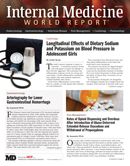Treating Lipid Levels in Young Adults: Pediatric vs. Adult Guidelines
Mark Twain said, "When I was a boy of 14, my father was so ignorant I could hardly stand to have the old man around. But when I got to be 21, I was astonished at how much the old man had learned in 7 years."

Mark Twain said, “When I was a boy of 14, my father was so ignorant I could hardly stand to have the old man around. But when I got to be 21, I was astonished at how much the old man had learned in 7 years.”
The transition from adolescence to adulthood changes kids in many ways. They face a litany of transitions — a world in which they’ll need to be more independent, and perhaps a first job, trade school, college and emotional growth.
Their health care needs change, too, and for health care clinicians, this can be a confusing time. Are these young people adolescents who should be approached from the perspective of pediatric guidelines, or adults who need to be treated following sometimes significantly different adult guidelines? That’s the essential question addressed by a team of researchers from four children’s hospitals in Boston, MA. Researchers focused on lipid levels, and their study appears in the June 2015 issue of JAMA Pediatrics.
Using the National Health and Nutrition Examination Survey (NHANES) population, the researchers analyzed surveys collected from approximately 6300 youths aged 17 to 21 years between January 1, 1999 and December 31, 2012. They applied two guidelines to the study population to determine the proportion of patients eligible for statins:
· The 2011 Integrated Guidelines for Cardiovascular Health and Risk Reduction in Children and Adolescents of the National Heart, Lung, and Blood Institute and
· The 2013 Guideline on the Treatment of Blood Cholesterol to Reduce Atherosclerotic Cardiovascular Risk in Adults from the American College of Cardiology and American Heart Association
The team then extrapolated the results to 20.4 million non-institutionalized young people.
In this population, 2.5% qualified for statin treatment under the pediatric guidelines. A significantly lower proportion of 0.4% qualified under the adult guidelines. The researchers indicated if pediatric guidelines (rather than adult guideline) were applied to the entire US population of youths aged 17 to 21, more than 400,000 additional young people would be treated.
Youths who met pediatric criteria had lower mean (SD) LDL-C levels but were much more likely to have other cardiovascular risk factors. Three modifiable risk factors were noteworthy: hypertension, smoking, and obesity. Counseling on lifestyle changes is critical.
The researchers’ recommendations are similar to the guidelines’ recommendations when data are conflicting or inadequate: physicians need to educate youths about potential benefits and harms of elevated lipids, and treatment or failure to treat. Sharing decision-making with the patient incorporated patient preferences into the clinical plan.
